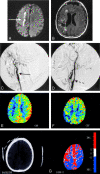Stenting and angioplasty of the symptomatic chronically occluded carotid artery
- PMID: 17213450
- PMCID: PMC8134119
Stenting and angioplasty of the symptomatic chronically occluded carotid artery
Erratum in
- AJNR Am J Neuroradiol. 2007 Mar;28(3):400
Abstract
Patients with hemodynamic impairment ipsilateral to a carotid occlusion are at a high risk of subsequent stroke, and currently 2 surgical options have been studied: extracranial-to-intracranial bypass and direct thromboendarterectomy. We report the successful revascularization of 2 symptomatic chronically occluded carotid arteries with stenting and angioplasty.
Figures


References
-
- Jovin TG, Gupta R, Uchino K, et al. Emergent stenting of extracranial internal carotid artery occlusion in acute stroke has a high revascularization rate. Stroke 2005;36:2426–30 - PubMed
-
- Adams HP, Powers WJ, Grubb RL, et al. Preview of a new trial of extracranial to intracranial arterial anastamosis: the carotid occlusion surgery study. Neurosurg Clin North Am 2001;12:613–24 - PubMed
-
- Terada T, Yamaga H, Tsumoto T, et al. Use of an embolic protection system during endovascular recanalization of a totally occluded cervical internal carotid artery at the chronic stage. Case report. J Neurosurg 2005;102:558–64 - PubMed
-
- Gonzalez A, Gil-Peralta A, Gonzalez-Marcos JR, et al. Angioplasty and stenting for total symptomatic atherosclerotic occlusion of the subclavian or inominate arteries. Cerebrovasc Dis 2002;13:107–13 - PubMed
-
- Henry M, Amor M, Henry I, et al. Percutaneous transluminal angioplasty of the subclavian arteries. J Endovasc Surg 1999;6:33–41 - PubMed
Publication types
MeSH terms
LinkOut - more resources
Full Text Sources
Medical
